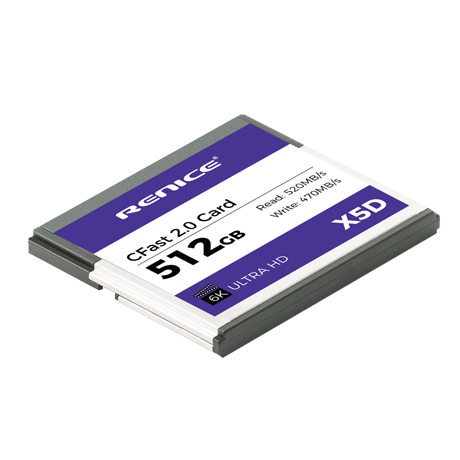Renice Launches Ultra-High-Speed CFast 2.0 Memory Cards
In 1975, Kodak produced a digital camera similar to a machine tool, and since then the era of digital cameras has begun. 21 years later, Kodak released the DC25 camera with a CF card, thus establishing the camera's memory card system. The memory card is one of the very important accessories of the camera. It not only can be used to store all the photos and videos taken, but also affects the smoothness of the shooting, which is closely related to the shooting quality. Generally, the memory cards used in cameras mainly include the following: CF card/CFast card, SD card, TF card and MMC card.
With the development of the economy and the advent of the era of national photography, cinema cameras are no longer far away for people. Cinema camera manufacturers are also constantly updating their products to meet people's needs. In addition to the pursuit of camera enthusiasts, the needs of the general public have a great impact on cinema cameras. The most direct manifestation is that people have higher and higher requirements for film and video, and 4K and 6K high-definition videos has become the best choice for people. Cinema cameras and camera memory cards face many challenges as people become more demanding. Larger memory capacity, faster read and write speed, lower power consumption, and better heat dissipation performance have become the problems that need to be solved for the new generation of cinema cameras memory cards.
To solve these problems, Renice has launched a new Ultra-High-Speed CFast 2.0 Memory Card. Renice CFast 2.0 is a compact memory card with SATAIII 6.0Gbps interface, compatible with CFast 2.0 standard and ATA protocol. It combines the ultimate speed, extreme reliability and ultra-low power consumption required to shoot cinematic quality 4K and 6K HD video, and is suitable for mainstream camera brands and models on the market.

1. Compact and large capacity, designed for cinema cameras
Renice CFast 2.0 is a compact memory card with SATAIII 6.0Gbps interface, compatible with CFast 2.0 standard and ATA protocol. The large storage capacity is up to 960GB, breaking the capacity limitation of traditional camera memory cards and meeting the capacity requirements of different shooting situations.
2. Ultra-high continuous read/write speed, P/E Cycles is more than 5000 times
Renice CFast 2.0 memory card has a continuous writing speed of up to 470MB/s, supports high-speed continuous shooting without being affected, and can withstand high-bit rate video shooting. The data transfer speed is as high as 520MB/s, which can quickly review video and movie files, and quickly export large-capacity files in the memory card. At the same time, Renice CFast 2.0 adopts pSLC flash memory technology, and the P/E Cycles is more than 5000 times, which greatly prolongs the service life of the memory card.
3. Ultra-low power consumption design to alleviate heating problems
The Renice CFast 2.0 memory card adopts a low-power design, with a minimum power consumption of 0.2W in idle state and 0.85W in non-idle state. Effectively relieve the memory card from not working due to heat during operation, and improve the operating efficiency of the camera and memory card.
4. High temperature resistance, adapt to harsh shooting environment
Renice CFast 2.0 memory card can operate continuously in the temperature range of 0ºC to +70ºC and can be stored in ultra-low temperatures of -40°C to +85°C. Renice CFast 2.0 Card has the characteristics of high temperature resistance, moisture resistance, impact resistance, etc., ensuring that it can operate normally in harsh shooting environments.
